More Woodland and Garden Birds: Thrushes
While you have seen in the previous blog some of the birds that take food directly from garden feeders the following ones will cover those that that also live in our woodlands and may appear in our gardens as well. For some, there is the advantage of taking any feed scattered from the feeder and tray by the smaller birds. For others the garden is just an extension of their woodland habitat and they use it to find food of the same type that they eat in the woods.
Thrushes
There are two members of this family that commonly visit some gardens in Dalgety Bay. The sweet song of the Blackbird must be one of the most recognisable sounds to accompany any walk through the woodlands and is a great accompaniment to any time spent in the garden, especially in the evening.

It is the smart male with the bright beak that is the songster, and as they can have several broods each summer, he will sing to declare his territory, including the nest site, over most of the summer.

The female is much duller in plumage as she needs to be hidden from potential predators when sitting on the nest. The one in the photograph was collecting mud to provide a smooth lining to the inside of the nest.
While Blackbirds will take some scattered food from the feeders, or that put out specially for them, they are mostly to be seen searching the bare ground for various invertebrates, or garden lawns for worms. In the woodlands they turn over dead leaves to reveal any suitable prey. In dry periods when the ground is too hard and the worms are too deep, they can be seen taking small slugs from among any leaves that less assiduous gardeners have left to accumulate at the lawn edge. Slugs are protected by a sticky slime and they will hold them in their beak and wipe them repeatedly on the lawn grasses to remove as much of this as possible before eating them or taking them to their nestlings. Blackbirds are also keen soft fruit eaters as anyone will know if they try to grow Blueberries without protective netting, and later in the year will defend a tree with berries such as a Cotoneaster or Rowan.

Another member of the Thrush family that benefits from our woodlands and adjacent gardens is the Song Thrush. This is a red listed species of great concern as populations have plummeted, especially in the south where intensive farming has reduced many of their food sources. They too will take worms and slugs, but their speciality is eating snails.

If you look at areas of the woodland where there are stones proud of the soil you may notice a scattering of broken snail shells. Many are the rather pretty shells of the common Banded Snail, but they will also crack open the much larger shells of the Garden Snail that is responsible for most of the plant damage that gardeners hate to see. If you see these broken snail shells in your garden then you will know you have a Song Thrush helping to reduce snail numbers.
They are also strong singers, usually from the top of a tall tree, repeating the same phrase 3 or 4 times before moving to a different one and repeating it. They will go through a series of these phrases before repeating the sequence again. Since nesting is now well underway, they are not heard as much as they were a few weeks ago, but they are still singing and like the Blackbird will sing over much of the summer as they also have 2 or 3 broods per year.







































